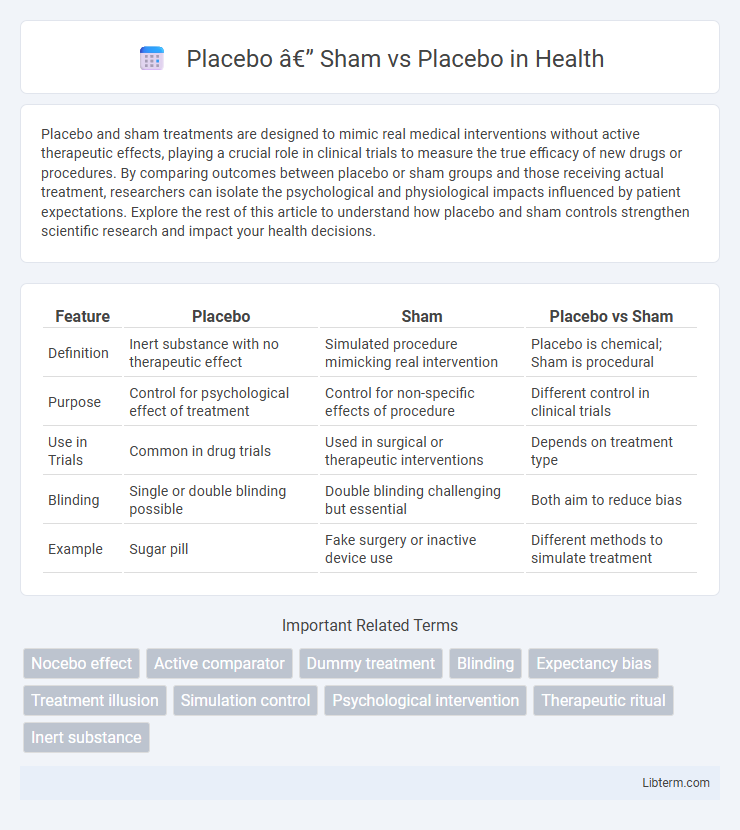Placebo and sham treatments are designed to mimic real medical interventions without active therapeutic effects, playing a crucial role in clinical trials to measure the true efficacy of new drugs or procedures. By comparing outcomes between placebo or sham groups and those receiving actual treatment, researchers can isolate the psychological and physiological impacts influenced by patient expectations. Explore the rest of this article to understand how placebo and sham controls strengthen scientific research and impact your health decisions.
Table of Comparison
| Feature | Placebo | Sham | Placebo vs Sham |
|---|---|---|---|
| Definition | Inert substance with no therapeutic effect | Simulated procedure mimicking real intervention | Placebo is chemical; Sham is procedural |
| Purpose | Control for psychological effect of treatment | Control for non-specific effects of procedure | Different control in clinical trials |
| Use in Trials | Common in drug trials | Used in surgical or therapeutic interventions | Depends on treatment type |
| Blinding | Single or double blinding possible | Double blinding challenging but essential | Both aim to reduce bias |
| Example | Sugar pill | Fake surgery or inactive device use | Different methods to simulate treatment |
Understanding Placebos: Definitions and Origins
Placebos are substances or treatments with no active therapeutic effect, used primarily in clinical trials to test the efficacy of new medications or interventions. The term "placebo" originates from Latin, meaning "I shall please," and historically referred to treatments meant to satisfy patients rather than cure ailments. Sham treatments, often confused with placebos, specifically imitate the physical aspects of a procedure without the active component, facilitating the study of placebo effects in interventions like surgery or physical therapy.
The Science Behind Placebo Effects
Placebo effects arise from the brain's response to an inert treatment, triggering real neurobiological changes such as the release of endorphins and dopamine. Sham procedures mimic therapeutic interventions without active components but still engage patients' expectations, demonstrating the powerful influence of perception on health outcomes. Understanding the science behind placebo effects involves exploring psychological and physiological mechanisms that modulate symptom relief beyond pharmacological action.
What is a Sham? Distinguishing Sham from Placebo
A sham procedure mimics a genuine medical intervention without the active therapeutic element, often used in clinical trials to control for the psychological impact of receiving treatment. Unlike a placebo, which typically involves an inert substance like a sugar pill, a sham involves a simulated procedure designed to appear real. Distinguishing sham from placebo is crucial for accurately assessing treatment efficacy and eliminating bias in experimental studies.
Historical Context: Placebo and Sham in Medical Trials
The historical context of placebo and sham controls in medical trials dates back to the 18th century when placebo was first used to account for psychological effects in treatment outcomes. Placebos are inert substances designed to mimic real drugs, while sham procedures replicate surgical or physical interventions without therapeutic intent, ensuring unbiased assessment of efficacy. These controls have been fundamental in establishing rigorous standards for clinical trial methodology, safeguarding against placebo effects and observer bias.
Placebo Mechanisms: How the Mind Influences Healing
Placebo mechanisms involve the brain's ability to trigger real physiological changes through belief and expectation, activating endogenous pain relief systems and modulating neurotransmitters like dopamine and endorphins. Placebo effects demonstrate how cognitive processes influence healing by altering immune response, hormone release, and neural connectivity, highlighting the mind-body connection in medical outcomes. Understanding these mechanisms enhances clinical practice by optimizing therapeutic environments to maximize patient response without active pharmacological agents.
Sham Procedures: Applications in Clinical Research
Sham procedures play a critical role in clinical research by serving as placebo controls to isolate the true effects of an intervention from psychological or procedural influences. These carefully designed interventions mimic the active treatment without delivering its therapeutic element, enabling researchers to assess efficacy and safety more accurately. Their application spans various medical fields including surgery, neurology, and pain management, ensuring rigorous trial design and unbiased outcome measurement.
Ethical Considerations: Using Placebo and Sham Interventions
Placebo and sham interventions serve as critical controls in clinical research, with placebos typically involving inactive substances and shams simulating procedures without therapeutic effects. Ethical considerations center on informed consent, ensuring participants understand the nature of these interventions and potential risks without deception. Balancing scientific rigor with participant welfare demands strict adherence to ethical guidelines, emphasizing transparency and minimizing harm while preserving study validity.
Placebo vs Sham: Key Differences and Similarities
Placebo and sham controls are essential in clinical trials to isolate psychological and procedural effects from actual treatment outcomes. Placebo typically refers to an inert substance designed to mimic a drug without therapeutic activity, while sham involves a fake procedure replicating the actions of an intervention without therapeutic intent. Both serve to control for expectancy effects, but sham controls are often used in surgical or device studies where blinding participants to the physical procedure is necessary.
Real-World Examples: Placebo and Sham in Practice
Placebo and sham treatments differ significantly in clinical practice; placebos typically involve inert substances like sugar pills, whereas shams mimic the procedural aspects of a treatment without its therapeutic element. Real-world examples include placebo-controlled drug trials where patients receive inactive pills, and sham surgeries in orthopedic studies where incisions are made without the actual surgical intervention. These methods provide crucial controls to isolate treatment effects, enhancing the validity of clinical outcomes in research settings.
Future Directions: Innovations in Placebo and Sham Research
Future directions in placebo and sham research emphasize the development of personalized placebo interventions utilizing biomarkers and neuroimaging to enhance efficacy and predict individual responses. Advanced machine learning algorithms are being integrated to decode placebo mechanisms and optimize sham controls in clinical trials, thereby improving data validity. Emerging innovations also explore digital and virtual placebo applications to refine patient engagement and therapeutic outcomes.
Placebo — Sham Infographic

 libterm.com
libterm.com